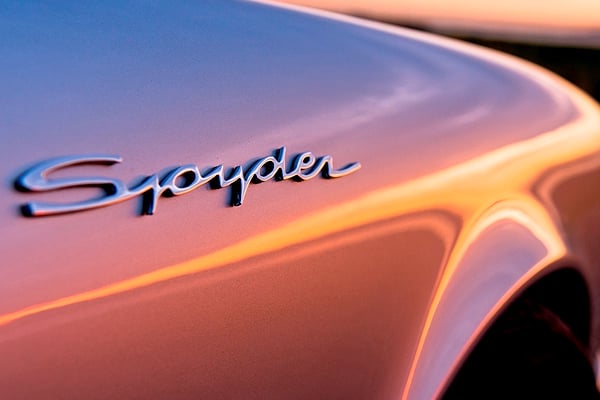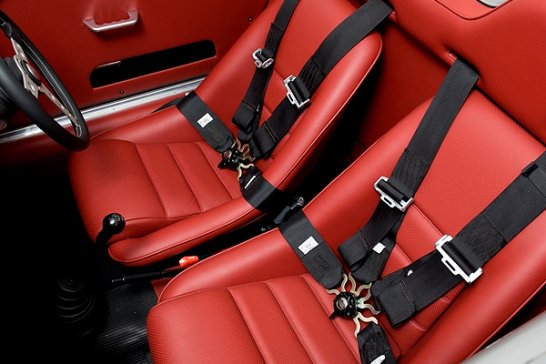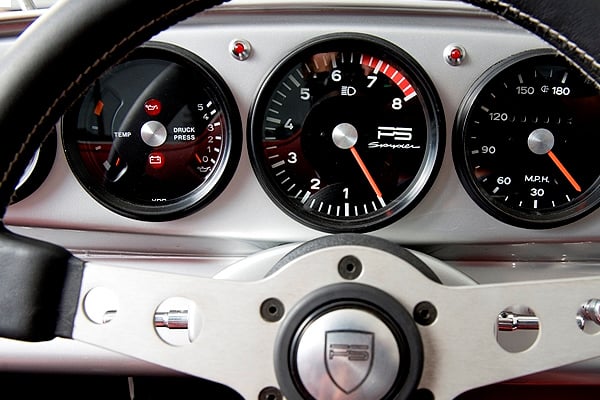
Oddly, despite producing countless special editions and limited production versions of the car which embodies its brand, Porsche has never produced a Spyder version of the 911. This led Essex-based Porsche fanatic Paul Stephens to take matters into his own hands.
Paul Stephens is no stranger to giving a classic Porsche a little TLC: he’s well-known in the Porsche community (and wider – he also restores other luxury marques) as an independent specialist. But this project was a little different from his usual, and rather than resuscitating a slightly tired old model, he decided to completely reincarnate one as the 911 Spyder that never was.
The donor car fortunate enough to be selected by Stephens began life as a 1989 3.2-litre Targa. Weighing in at 1300kg, it needed to be put on a strict diet to have a chance of emulating its namesake: the Spyder moniker has only been applied to lightweight, open-top sports cars, beginning with the 1953 Porsche 550 and continuing today in the form of the 2010 Boxster Spyder.


Understanding the Spyder formula is simple – low weight, low drag, little or no windscreen and no roof – however, executing it is a little more difficult. Stephens sacrificed the front and rear screens, roll hoops and the majority of the heater system, and also replaced the car’s hefty original bumpers with some composite parts which he fabricated himself. These changes, along with some extensive steel-for-aluminium swappage on the car’s bodywork, bring the weight down to 950kg.
Stephens admits that basing the car on an earlier coupé could have dropped the mass down further, to around 800kg. However, he insists that the Targa shell was a better concession: “The PS Spyder was never intended to be a Caterham chaser, it doesn’t compromise all of its comfort and ease-of-use in pursuit of light weight”. The Targa’s added steel bracing provides extra rigidity and the G50 gearbox, while being heavier, is more robust and has a slicker change than the 915 unit from the earlier coupés.
Obviously, where the PS Spyder really distances itself from its former identity is in its bodywork. The rear luggage cover with twin head-fairings is made from aluminium by Stephens and reflects the original Spyder units, right down to the red leather headrests. Another Spyder principal – in the form of the shallow Perspex windscreen – is also addressed. Although it obviously won’t provide protection from the elements like its former self, you don't get the buffeting you may expect: occupants sit lower in the PS Spyder than in a Targa.


The driver is also seated more centrally than in a standard 911, meaning the offset pedals are less of a nuisance. This theme is continued throughout the interior – Stephens has used his years of experience in dealing with these types of car to make subtle but effective changes, paying particular attention to detail along the way. For example, the dials echo the original Stuttgart items, but are recalibrated so they can be seen through the smaller steering wheel. The same is seen with the gearknob, which is a faithful recreation of a pre-1973 item but remade to display the shift pattern of the current gearbox.
Over 2000 hours of labour have gone into Paul Stephen’s 911 Spyder, which was built as a one-off for him to display the levels of craftsmanship that his company is capable of. It will be put up for sale towards the end of the year, and interested parties can contact him on +44 (0) 1440 714 884.
Text: Joe Breeze
Photos: paul-stephens.com





